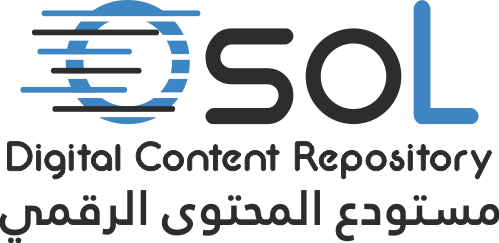الرجاء استخدام هذا المعرف للاستشهاد او الربط بهذا البحث :
https://dspace.qou.edu/handle/194/2602| العنوان: | The Palestinian Persona in the Arabic novel: The Arab Gulf, the Arab Maghreb and the Levant Settings – A Model |
| المؤلفون: | Yousof Ibrahim Yousof Al-Refai يوسف إبراهيم يوسف الرفاعي |
| الكلمات الرئيسية: | The Palestinian Persona, the Arabic Novel, the Fictional Character, the Character in literary criticism. شخصية الفلسطيني، الرواية العربية، الشخصية الروائية. |
| تاريخ النشر: | 2020 |
| الناشر: | جامعة القدس المفتوحة/Al-Quds Open University |
| ملخص: | This study deals with the Palestinian persona in the contemporary Arabic novel within three settings: The Arab Gulf, the Maghreb, and the Levant. The study is based on a number of novels, whose authors excelled in employing Palestinian persona to determine its nature, roles, functions, dimensions, images and ways of displaying it, within an extra-textual setting and a narrative one that together show the extent of narrative honesty on one side and the researcher's success or failure on the other side. The study enhanced its goal and vision within an applied space through three novels from the three above mentioned settings: “Fi'ran ummi Hissa' (Mama Hissa's Mice) by Kuwaiti novelist Saud Alsanousi, “Ashbah al Quds (Ghosts of Jerusalem)” by the Algerian novelist, Wasini Al A’raj, and “Awlad al Ghetto- Esmi Adam (Children of the Ghetto-My Name is Adam)” by the Lebanese novelist Elias Khouri. The purpose of the study is to research the prominent models of the persona, in terms of what the narrator required in each environment or what the practical side required for each of the three novels. It is not surprising that the levels of dealing with the persona overlap to combine the post-narrative genes as in the case of the image of woman and the image of the socially influential persona with the narratively acquired gene that shows the heroic, problematic, or anxious persona and what combines both levels, as to the lost lover and the inferior intellectual. The study includes three chapters that aimed to reveal the true nature of the Palestinian persona. The first one deals with the concept of the narrative persona, while the second addresses the employment of the Palestinian persona in the three environments according to the narrative topic itself and the extent of the Palestinian agreement with him as a main or a secondary character, and the stereotyping which is based on the environmental or individual reference of the novelist. The third chapter revealed its relationship with the narrative vision, and clarified the nature of this relationship by balancing the traditional approach with the requirements of modernization methods in displaying the persona. This is what urged studying the persona in the three novels through the narrative model and the horizon of the novelist. The study relied mainly on the analytical descriptive approach and embodied stylistic and semiotic signals in aspects of it. The most prominent finding of the study is that employing the Palestinian persona in the Arabic novel occupied a realistic dimension with perfect seeds depending on the semantic density and the ability to carry the narrative subject and dominate it by the textual subjects, and its transfer from the searcher for a homeland and freedom to an objective symbolic accounting the absent humanity about the victim to an aesthetic meaning that establishes furnishing relationships in narrative structures and blocks. The peculiarity of each environment also has an impact on the employment of the Palestinian persona; for example, its image, presence, impact and manner of presentation had differed in the Maghreb novel from it in the Gulf one. The roles of the Palestinian in the Arabic novel extended from the secondary to the protagonist, always served as an anchor and influential factor of the fictional work and often far from arbitrariness. |
| URI: | https://dspace.qou.edu/handle/194/2602 |
| يظهر في المجموعات: | Arabic Language and Literature -ماجستير اللغة العربية وآدابها |
:الملفات في هذا العنصر
| ملف | وصف | حجم | النوع | |
|---|---|---|---|---|
| Yousof_Al-Refai.pdf | 35.78 MB | Adobe PDF | عرض\فتح |
جميع جميع الابحاث محمية بموجب حقوق الطباعة، جميع الحقوق محفوظة.
